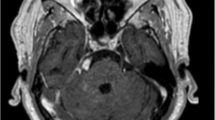Abstract
Trigeminal neuralgia (TN) is a paroxysmal shock-like pain restricted to the innervations of the areas of one or more trigeminal branches, often set off by light stimuli in a trigger zone. Pain attacks occur spontaneously, and can also be triggered by a nonpainful sensory stimulus to the skin, intraoral mucosa surrounding the teeth, or tongue. The pathogenesis of TN is uncertain and typically is idiopathic, but it may be due to a structural lesion. Various proposed causes include traumatic compression of the trigeminal nerve by neoplastic or vascular anomalies, infectious agents such as human herpes simplex virus, and intracranial tumors or demyelinating conditions such as multiple sclerosis. Here we report a case of a young patient diagnosed with trigeminal neuralgia secondary to epidermoid cyst at the cerebellopontine angle.
Similar content being viewed by others
References
Okeson JP. Bell’s orofacial pains: the clinical management of orofacial pain. Chicago: Quintessence Publishing; 2005.
Scrivani SJ, Mathews ES, Maciewicz RJ. Trigeminal neuralgia. Oral Surg Oral Med Oral Pathol Oral Radiol Endod 2005;100: 527–38.
Love S, Coakham HB. Trigeminal neuralgia: pathology and pathogenesis. Brain 2001;124:2347–60.
Cirak B, Kiymaz N, Arslanoglu A. Trigeminal neuralgia caused by intracranial epidermoid tumor: report of a case and review of the different therapeutic modalities. Pain Physician 2004;7:129–32.
Maya MM, Lo WW, Kouvanlikaya I. Temporal bone: tumors and cerebellopontine angle lesions. In: Som PM, Curtin HD, editors. Head and Neck Imaging, 6th ed. St. Louis: Mosby Elsevier; 2003. p. 1288, 1290.
Kobata H, Kondo A, Iwasaki K. Cerebellopontine angle epidermoids presenting with cranial nerve hyperactive dysfunction: pathogenesis and long-term surgical results in 30 patients. Neurosurgery 2002;50:276–85.
Goh BT, Poon CY, Peck RH. The importance of routine magnetic resonance imaging in trigeminal neuralgia diagnosis. Oral Surg Oral Med Oral Pathol Oral Radiol Endod 2001;92:424–9.
Ochi M, Hayashi K, Hayashi T, Morikawa M, Ogino A, Hashmi R, Iwanaga M, Yasunaga A, Shibata S. Unusual CT and MR appearance of an epidermoid tumor of the cerebellopontine angle. Am J Neuroradiol 1998;19:1113–5.
Desai K, Nadkarni T, Bhayani R, Goel A. Cerebellopontine angle epidermoid tumor presenting with ‘tic convulsif’ and tinnitus. Neurol Med Chir (Tokyo) 2002;42:162–5.
Bagheri SC, Farhidvash F, Perciaccante VJ. Diagnosis and treatment of patients with trigeminal neuralgia. J Am Dent Assoc 2004;135:1713–7.
Author information
Authors and Affiliations
Corresponding author
Rights and permissions
About this article
Cite this article
Guttal, K.S., Naikmasur, V.G., Joshi, S. et al. Trigeminal neuralgia secondary to epidermoid cyst at the cerebellopontine angle: case report and brief overview. Odontology 97, 54–56 (2009). https://doi.org/10.1007/s10266-008-0088-x
Received:
Accepted:
Published:
Issue Date:
DOI: https://doi.org/10.1007/s10266-008-0088-x




